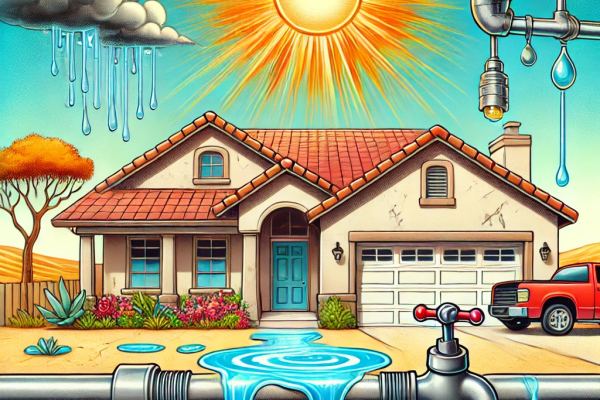
Water: Your Friend and Enemy - How Leaks Damage Homes and Wallets (Especially in Texas)
Water is life. It’s a daily comfort—a refreshing shower after a scorching Texas day or a cool drink on a hot afternoon. But when this precious resource escapes pipes where it’s not supposed to, it becomes your worst enemy. Water leaks are silent destroyers that can harm not only your home’s structure but also your financial stability.
For Texans, water leaks pose an even greater risk. This state’s extreme weather conditions, with temperature swings, droughts, and aging infrastructure, push plumbing systems to their limits. This guide will help you recognize leaks, tackle them effectively, and minimize the damage.
Water Leaks: Not Just a Minor Problem
Picture this: a small damp spot on your ceiling or the faint sound of water running when no one is using the faucet. "It’s no big deal," you think. "I’ll fix it later." However, a water leak, like a slow but relentless enemy, won’t wait for you.
What Happens if You Ignore a Leak?
Structural Damage to Your Home
- Continuous exposure to water weakens building materials. Drywall softens and loses shape, wooden beams rot, and laminate floors warp.
- If water reaches your foundation, cracks and structural weakening are inevitable.
Mold and Mildew Growth
- A damp environment becomes a haven for mold. These unwelcome guests not only ruin your home’s appearance but can also trigger allergies and respiratory illnesses.
Soaring Water Bills
- Think a few drops a minute aren’t a big deal? Think again. A dripping faucet can waste up to 3,000 gallons of water annually, adding significant costs to your utility bills.
Decline in Living Conditions
- Musty smells, stains on ceilings and floors, and mold in the bathroom can transform a cozy home into a source of constant stress.
Why Water Leaks Are a Major Issue in Texas
Texas’ climate makes leaks particularly dangerous. Here’s why:
Temperature Swings
- Winter freezes can cause pipes to burst, especially those outside or in unheated spaces. In spring, thawing adds pressure that may lead to cracks.
Drought Conditions
- During droughts, water pressure in pipes often increases, especially if you’re watering your lawn or filling a pool. This added stress can lead to leaks.
Flooding
- Heavy rains can saturate the ground, causing underground pipes to shift, crack, or clog. Water intended to flow away ends up causing damage instead.
Aging Infrastructure
- Many Texas neighborhoods still rely on plumbing systems installed decades ago. Metal corrodes, and plastic deteriorates—leaks become inevitable.
How to Identify a Leak in Your Home
Obvious leaks, like a dripping faucet, are easy to spot. But hidden leaks inside walls or underground can go undetected for months, causing significant damage. Look out for these signs:
- Unusually High Water Bills: If your water bill spikes without a change in usage, it’s likely a hidden leak.
- Sounds of Running Water: Hearing water flow when all faucets are off could mean a problem in your pipes.
- Stains on Walls or Ceilings: Yellow or brown discoloration often indicates water seeping through.
- Wet Spots on Floors: Unexplained damp areas, especially in non-wet zones like bedrooms or hallways, are red flags.
- Musty Odors or Mold: If your home smells damp, it’s often due to water accumulation from a leak, even if you can’t see it.
Simple Methods to Detect Leaks
Suspect a leak but not sure? Try these easy detection methods:
Check Your Water Meter
- Turn off all water-using appliances and note the meter reading. Wait 1-2 hours and check again. If the numbers have changed, you’ve got a leak.
Inspect Accessible Pipes
- Look under sinks, in basements, and attics for signs of moisture, rust, or condensation.
Use Paper or Cloth
- Place these under suspected areas. Wet spots confirm the problem.
Install Water Sensors
- Affordable devices can alert you to leaks by detecting water where it shouldn’t be. Place them near water heaters, washing machines, and in basements.
What to Do If You Find a Leak
Discovering a leak is stressful, but acting quickly can save you time and money. Here’s what to do:
- Shut Off the Water: Use the shut-off valve to stop water flow to the affected area.
- Assess the Damage: Minor leaks might be manageable on your own. For severe issues, call a professional.
- Apply Temporary Fixes: Waterproof tape or sealants can stop the leak temporarily until help arrives.
- Contact a Professional: Texas plumbers are equipped with tools like cameras and thermal imaging to pinpoint and fix leaks with minimal disruption.
Prevention: The Best Defense Against Leaks
As they say, prevention is better than cure. Follow these tips to avoid leaks:
- Regular Inspections: Check your plumbing system annually, especially in unheated areas and basements.
- Insulate Pipes: This is crucial during Texas winters to prevent freezing and bursting.
- Upgrade Old Systems: If your home’s plumbing is over 20 years old, consider replacing it. Modern materials are more resistant to corrosion and temperature changes.
- Install Protective Systems: Smart devices, like automatic water shut-off systems, can prevent catastrophic damage.
Real Stories From Texas Homes
Dallas: Winter Freezes and Ruined Floors
A family discovered the aftermath of a burst pipe in their attic after a harsh winter freeze. Water ruined their first floor, costing $15,000 in repairs. Insulating the pipes could have prevented this.
Austin: The Hidden Leak
Mold in the bathroom seemed minor until homeowners found a leaking pipe behind the wall. It had been dripping for months, damaging the walls and floors.
Houston: Shifting Ground, Shifting Pipes
After heavy rains, a homeowner noticed cracks in the foundation. A plumber found an underground pipe had shifted and broken, requiring extensive repairs.
Conclusion: Make Water Your Ally, Not Your Enemy
Water leaks aren’t just minor inconveniences. They threaten your home, health, and budget. But with timely action, regular checks, and modern tools, you can mitigate the risks.
Texans, don’t let water become your foe. Turn this essential resource into your ally by protecting your home and conserving this vital element for future generations.






